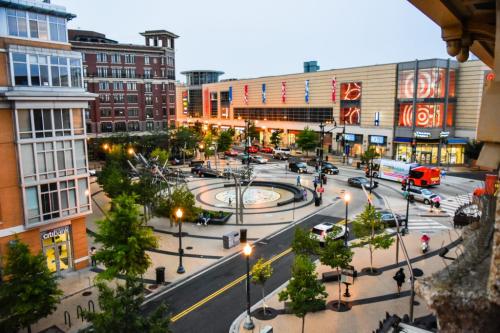Placemaking Postcards is a blog series from the Bass Center for Transformative Placemaking at Brookings where policymakers and practitioners guest-author promising placemaking efforts from across the U.S. and abroad that foster connected, vibrant, and inclusive communities. In line with the principle tenets of placemaking, the goal of the series is to recognize the community as the expert, highlight voices from the field, and to create a community of learning and practice around transformative placemaking.
The skyrocketing housing prices of the pandemic era have cooled since their peak in June 2022, but still remain far too high for many. Last year, the median American home price topped $400,000 for the first time, and the burden on renters is increasing too, with the national average of rent-to-income reaching a two-decade high of 30% in 2023.
Importantly, these impacts are being felt across generations. Many younger adults, saddled with student loan debt, are finding themselves without the savings or monthly earnings to qualify for a mortgage or afford rents. Meanwhile, an increasing number of older single homeowners have too much house to take care of and no feasible way to downsize without leaving their neighborhoods. And across all ages, these challenges are exacerbated in majority-Black neighborhoods, largely due to histories of racial segregation and fewer banking options, and now, gentrification and the quickening pace of institutional investors buying up properties. In historically Black neighborhoods adjacent to universities, these challenges can be compounded by encroaching development that caters to university-affiliated populations and young professionals.
In Philadelphia—the poorest big city in the country and one still reeling from pandemic-era housing market disruptions—the interlocking challenges of high housing costs, displacement pressures, and a lack of aging-in-place options are converging in the historically Black West Philadelphia neighborhood of Mantua, which borders University City (home to Drexel University, University of Pennsylvania, Children’s Hospital of Philadelphia, and other institutions).
This piece highlights a Drexel University and community partnership, Second Story Collective, which is addressing these issues by helping low-income residents at opposite ends of the age spectrum access affordable housing in university-adjacent neighborhoods through an intergenerational community collective of home-sharers that can be replicated nationwide.
From sharing stories to sharing homes
West Philadelphia’s Mantua neighborhood has a poverty rate nearly twice the city’s (46% compared to 26%), but rental rates and housing prices there have been steadily and steeply increasing for a decade—threatening to displace long-term residents while also creating a barrier for lower-income students to afford rental housing. Like many market disruptions the pandemic exacerbated, this long-simmering tension is reaching a boiling point.
The origins of Second Story Collective’s intergenerational home-sharing model reflect—and are designed to respond to—this tension. In 2014, Drexel’s Dornsife Center for Neighborhood Partnerships started Writers Room—a literary arts academic and community-based program co-created by students, faculty, and community members to amplify voices and stories, archive histories, and celebrate diverse perspectives.
Only a few months into this endeavor, Carol Richardson McCullough (a co-author of this piece) told her fellow Writers Room members that her landlord was evicting her family to market the building to Drexel students. It was then that the Writers Room’s students, artists, elders, and activists became acutely aware that they were, in fact, part of one another’s stories. Out of this moment, the idea for Second Story Collective was born.
One Writers Room member (and another co-author), Barbara Dale, introduced us to the Quaker tradition of home-sharing in the City of Brotherly Love, beginning with the history of the first racially integrated housing cooperative, Friends Housing Cooperative, in 1952. Writers Room members then began imagining a project for aging-in-place and intergenerational home access that could, in McCullough’s words, be a new exploration in “neighborhood placement rather than the displacement that has historically accompanied university expansion into neighborhoods.”
Over nine years, Writers Room has grown from a just handful at the first meeting to a lasting group of over 50 members who are diverse across race, religion, socioeconomic status, sexuality, gender, and age, and who continue to participate after graduating or moving out of the neighborhood. In that time, the group has co-developed the Second Story Collective community-university home-sharing model with three primary goals:
- Co-create a home-sharing network in which Drexel University students and neighbors live together in intentional communities rooted in storytelling and sharing.
- Provide viable affordable rental, housing, and anti-displacement options—with students paying below-market rent that subsidizes the homeowners’ mortgages—while cultivating partnerships with city agencies and nonprofits to help older homeowners repair and retrofit their homes so they can age in place.
- Help neighborhood families become homeowners and create new generational wealth by partnering with a developer to produce new homes in Mantua—designed from the foundation up as intergenerational co-housing.
By helping elder members of the community remain in their homes longer and encouraging connection and community-building across generations as part of the rental and homeownership process, the model hopes to demonstrate how alternative affordable housing and rental options can benefit both low-income students and long-term residents.
With research and funding, a collective idea becomes collective action
Research and community leadership were instrumental in moving the Second Story Collective from an idea to an actionable project. Once it became clear through the lived experiences of Writers Room members that displacement and affordable housing were their most pressing issues, they used Drexel’s involvement and their shared knowledge to co-design a research agenda, plan for actionable change, and attract financial resources.
On the research side, Writers Room has partnered with Drexel’s Justice-oriented Youth (JoY) Education Lab and the Mantua Civic Association since 2018 on AmeriCorps-funded community-driven participatory action research to investigate the potential for cooperative living to combat displacement. Utilizing census data, the research team found that the displacement of Black residents is happening at faster and higher rates than initially hypothesized, with a 73% increase in the Mantua’s white population over the past 10 years. Further analysis of a sample block group in Mantua revealed rental rates rose over 44%, with a 74% increase in rent-burdened households (those paying more than 30% of their income on rent) and a 454% increase in extremely rent-burdened household (those paying more than 50% of their income on rent).
Building off these findings and community input, Writers Room has received several new sources of funding. In 2021 and 2022, the Barra Foundation and Pennsylvania Department of Community and Economic Development provided funding to test the aging-in-place model in two homes and generate a proof of concept for project expansion and replication in other university-adjacent neighborhoods in Philadelphia and beyond. In 2022, the research team received a National Science Foundation planning grant to further develop a scalable model. And most recently, Writers Room received funding from the Mellon Foundation to help create a living-learning agreement between home-sharers in the Village Square on Haverford—a mixed-use development on a series of currently vacant lots. The development will include 18 for-sale homes that will provide intergenerational co-housing to help neighborhood families become homeowners while providing more affordable options for students. Ground-breaking for the first phase is scheduled for this spring, with expected completion of the 18 houses in 2024.
Writers Room is currently in the process of working with the Mantua Civic Association and the Urban League of Philadelphia to identify program participants, and will prioritize selling to long-term neighborhood residents. Additional selection criteria and the application process will be determined with community input.
Creating the potential for tangible, replicable affordable housing results in university-adjacent neighborhoods
Addressing the interlocking challenges of high housing costs, displacement, and lack of aging-in-place options—not only in Philadelphia, but nationwide—requires a creative, place-based approach that leverages and strengthens connections between individuals, groups, and organizations within the community and across sectors. Second Story Collective offers other university-adjacent communities an alternative housing strategy and an example of how anchor institutions can center the arts to bridge differences and enact real change.
As stated by Charles Lomax of Lomax Real Estate Partners, lead developer of the Village Square: “This is an opportunity to change the narrative of university-adjacent development from one of displacement of long-term residents to engagement and community-building.”
Photo: Courtesy of Writers Room













Commentary
How a university-community home-sharing collective is creating a new model for affordable housing in West Philadelphia
April 25, 2023